Posted by Anita on 12.14.09 8:00 AM

For two weeks each December, bloggers from all over the world offer a delectable array of food-related items for the Menu for Hope raffle. Last year, we raised $62,806 to help the UN World Food Programme feed the hungry. This year, we’re supporting a new initiative at the WFP called Purchase for Progress (P4P), which enables smallholder and low-income farmers to supply food to WFP’s global operation.
This year’s campaign runs December 14 to 25, and every $10 you donate earns you one virtual raffle ticket for the item of your choice. (To learn more, head over to Chez Pim and check out her Menu for Hope FAQ, or read the highlights at the bottom of this post.)
This year, we’re offering the following item, also focused on supporting small, local farms:
Bid Item UW02: Locavore Starter Kit
Many readers tell us that they’d love to eat more local foods, but they don’t know where to start. So we’re making it simple with a Locavore Starter Kit: A trial membership to the Soul Food Farm chicken-and-egg CSA (or another CSA of your choice* if you live outside the Bay Area) and a farmer’s market tour with breakfast and local treats.
- Soul Food Farm and Married …with Dinner are offering a $100 CSA credit toward the winner’s choice of whole chickens, eggs, olive oil, and other farm-fresh goodies. Pick up your winnings all at once, or spread it over multiple pickups: It’s up to you how to spend your CSA credit (subject to the usual order terms).
- Plus, Soul Food Farm farmer Alexis Koefoed offers a personal tour of Soul Food Farm for the winner and up to 3 guests at a mutually agreeable time in 2010.
- We’ll also include a personalized tour of the San Francisco Ferry Plaza Farmers Market, complete with breakfast or lunch for two, to help our winner find all the great foods they need to make the leap to la vida locavore.
- And if that’s not enough, we’ll also bring along a bag full of local treats and homemade goodies for you to take home after your walk-around. The bag will include some of our own preserves, and an assortment of treats from local folks — including a bag of brown rice and a jar of almond butter from Massa Organics.
* A special note for non-Bay Area bidders: If the winner’s residence is not located within 25 miles of a Soul Food Farm drop point, we’ll pay the first month’s box charges ($50 maximum) for any Community Supported Agriculture program in the winner’s area. And the market tour + breakfast portion is open to any winner, local or visitor, on any Saturday in 2010 (subject to Anita & Cameron’s availability). We can ship the goodie bag, but the winner would be responsible for all postage and packing charges.
To donate and enter the Menu for Hope raffle: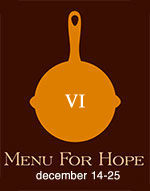
1. Choose bid item(s) from the main Menu for Hope list.
2. Visit the Firstgiving Menu for Hope page; make a donation.
3. Please specify which bid item(s) you’d like in the ‘Personal Message’ section of the donation form. You must write in how many tickets per bid item; please use the bid-item code. Each $10 you donate will give you one raffle ticket. For example, a donation of $50 can be 2 tickets for UW01 and 3 tickets for UW02 (written as 2xUW01, 3xUW02). The code for our Locavore Starter Kit is UW02.
4. If your company matches your charity donation, please check the box and fill in the information so Menu for Hope can claim the corporate match.
5. Please allow us to see your email address so that we can contact you in case you win. (Don’t check the box to keep your address private). Your email address will not be shared with anyone.
Check back here on Monday, January 18, for the results of the raffle. Good luck to everyone, and thanks for supporting such a worthy cause!
farms & farmers, giving back, locavore, Menu for Hope
7 Comments »




Posted by Anita on 12.13.09 1:21 PM
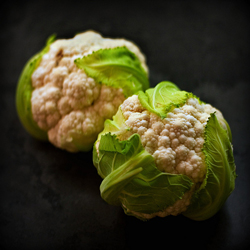 I like to think of myself as a spontaneous person, but I can be… shall we say “resistant”?… to last-minute changes. I’m trying to change, to become a little more flexible, and when I break out of my best-laid plans, oftentimes I’m rewarded.
I like to think of myself as a spontaneous person, but I can be… shall we say “resistant”?… to last-minute changes. I’m trying to change, to become a little more flexible, and when I break out of my best-laid plans, oftentimes I’m rewarded.
A case in point: On Monday, I made a delicious-sounding braised brisket from the October issue of Gourmet. I’d been thinking all weekend about how I would document the recipe for this week’s Dark Days Challenge meal. I planned photos, even brainstormed ideas describing brisket as the perfect braise for chilly autumn.
But although the brisket itself cooked up to a melting perfection (and the ingredients made for some pretty pictures) the sauce was too tomato-y and sweet, a rather one-dimensional result. Definitely not the sort of recipe I like to share with you here. Luckily, we had a pantry and fridge full of other local options, and another few day’s worth of possibilities before the weekly roundup. It took us until Friday night to find a recipe worth sharing, but oh was it worth the wait.
I’ve started collecting chicken recipes in an effort to keep our weekly CSA deliveries from becoming too mundane. No matter how much we love roast chicken (and love it we do) it’s hard for me to work up enthusiasm, week in and week out, for even the most perfectly golden bird. We’ve got a nice little rotation going: Pan-seared, braised, pot pies, jambalaya, coq au vin — it’s all good. But we’re always on the lookout for new ideas to keep things fresh.
When I came across this recipe in one of my favorite cookbooks, I couldn’t even remember the last time I’d made chicken paprikash. I vaguely recalled a version made with boneless, skinless chicken breasts and low-fat sour cream from my deluded college years. But as we prepped the ingredients, it became increasingly clear that this hearty braise was nothing like the over-stewed, excessively tart rendition of my youth.
Tempted by the rich, spicy smells we’d endured for close to an hour, we dove into our meals. Silence descended on the table, broken only by “wow”s and “mmm”s. As he polished off the last bite, Cameron looked me in the eye and said: “That is definitely a keeper.” I was too busy licking my plate to disagree.
Maybe it’s the quick dredge in flour that gives the sauce a silky texture. Maybe it’s browning the meat in bacon drippings — never a bad idea when it comes to flavor. Maybe it’s the addition of fresh frying peppers, alongside the usual dried paprika. Or maybe it’s the rich swirl of crème fraiche at the end, instead of garden-variety sour cream. Whatever the reason, this particular version transcends the genre’s often-lackluster norm.
There’s just one small problem: Like most braises, even the world’s most delicious chicken paprikash looks like a pile of mush. Which explains why you’re looking at the beautiful Swanton cauliflower that we served alongside our brown, lumpy main course. Our first of the year, each head was the size of a softball at most, and mineral-y sweet. Instead of steaming it as we usually do, we quick-braised the florets in a shallow pan; I’m more convinced than ever that just about every vegetable tastes amazing cooked this way.
If I were making this meal over again — especially if I were planning on photographing it — I might choose a green vegetable for a side dish. But honestly, I don’t know how we could have enjoyed it any more.
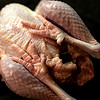

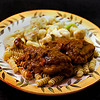
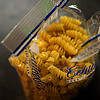

Chicken Paprikash
– adapted from Kitchen Sense
a 4- to 4.5-pound chicken, cut into 10 even pieces
2T oil
2T bacon fat, lard, or additional oil
1/2 cup all-purpose flour
1 medium onion, chopped
1 large garlic clove, minced
1 large or 2 large small Italian frying peppers, seeded and chopped
2T sweet Hungarian paprika (or a mix of sweet + hot)
1 cup chicken stock
1/2 cup white wine
1 large ripe tomato, peeled and cut into chunks, or 2 canned/frozen tomatoes, cut up
1/2 cup crème fraiche or sour cream
Rinse the chicken parts in cold water, and pat dry. Generously season the pieces with salt and pepper.
Heat the oil and bacon fat in a dutch oven or other heavy, wide pot over medium-high heat. Dredge the chicken in flour, shaking off any excess, and place each piece in the hot fat, skin side down. Fry the chicken, turning as needed, until golden brown on all sides. Remove the chicken to a clean plate and keep warm near the stove.
Reduce heat to medium. Add the onion and garlic and cook until soft but not brown. Add the peppers and continue to cook until soft. Add the paprika and cook for a minute or two until you smell the spice; do not brown or it will turn bitter. Add the stock, wine, and tomato and stir well. Return the chicken to the pot, along with any juices from the plate, and nestle into the vegetable mixture; sauce should come about halfway up each piece.
Cover the pot, reduce the heat to low, and simmer for 30 minutes, stirring occasionally. Remove the cover and simmer until the cooking liquid has reduced by about half and the chicken starts to pull away from the leg bones, about an additional 20 minutes. When chicken is done, remove it to a clean plate. Remove the pot from the heat, and stir in the crème fraiche or sour cream. Taste and adjust seasoning as needed.
Serve the chicken over buttered noodles or spätzle, then top each portion with sauce.
Farmers and food artisans who created the ingredients for this week’s meal: 
Soul Food Farm, Vacaville: chicken
Bariani, Sacramento: Olive oil
Guisto’s Vita-Grain, South San Francisco: flour, sea salt(!)
Catalán Family Farm, Hollister: onions & garlic
Happy Quail Farm, East Palo Alto: frying peppers
Walter Hansel Winery, Russian River Valley: wine
Bellwether Farms, Sonoma: crème fraiche
Eduardo’s, San Francisco: pasta
Swanton Berry Farm, Davenport: cauliflower
…and our own home-cured bacon (rendered for fat), home-canned chicken stock, and homegrown tomatoes
Exemptions: paprika, black pepper
Dark Days challenge, locavore, recipes
6 Comments »




Posted by Anita on 12.06.09 1:49 PM
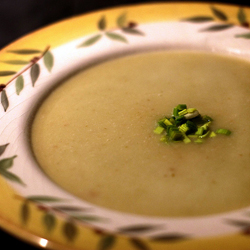 Some weeks — in fact, pretty much every week, if I’m being honest — I spend an hour or two each Friday night planning out the next seven days’ meals. I comb through the fridge and make a list of all the bits and pieces that didn’t get used up from the last market trip. Then I build a week’s menus based on what needs to get used up, and what we’re both craving. I almost always leave one or two dinners open either to market inspiration, or spontaneous (read: laziness-induced) dining out.
Some weeks — in fact, pretty much every week, if I’m being honest — I spend an hour or two each Friday night planning out the next seven days’ meals. I comb through the fridge and make a list of all the bits and pieces that didn’t get used up from the last market trip. Then I build a week’s menus based on what needs to get used up, and what we’re both craving. I almost always leave one or two dinners open either to market inspiration, or spontaneous (read: laziness-induced) dining out.
The only problem with this scheme is that sometimes we find ourselves at home without anything planned for dinner. Usually we’re content with something from the freezer — planned leftovers of stew, chili, or other easy-keeping meals — but this week we still had lots and lots of produce left from our last Mariquita Mystery Box delivery.
A big bunch of baby leeks and a handful of French red fingerling potatoes seemed like the natural base for a hearty, late-fall soup. I’ve made potato-leek soup before, but this version — where a small amount of bacon gets pureed into the base of the soup, rather than scattered on top — is now my all-time favorite. I can neither confirm nor deny that I ate two full bowls of the velvety, smokey stuff. Served with nothing more than a bowl of chilled radishes alongside and a scattering of the season’s first green garlic on top, it made for a perfect impromptu supper.
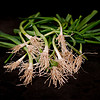

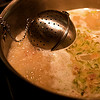

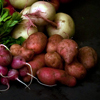
Potato-Leek Soup
adapted from Emeril Lagasse
1 pound leeks
2 bay leaves
20 black peppercorns
4 sprigs fresh thyme
2 T butter
2 strips bacon, chopped
1/2 cup dry white wine
5 cups chicken stock
1 pound starchy potatoes, peeled and diced
1-1/2 tsp salt
1/4 tsp white pepper
1/2 cup cream
2 T finely minced green garlic, chives, or tender leek greens
Tie together bay leaves, peppercorns and thyme into a cheesecloth bundle or infusing ball. Cut the white part of the leeks lengthwise and rinse well under cold water. Slice crosswise and set aside. Discard the greens, or save for making stock.
In a large saucepan, melt the butter over medium heat; when melted, add the bacon. Cook, stirring occasionally, until the bacon is soft and has rendered most of its fat; do not brown. Add the chopped leeks and cook until softened, about 5 minutes. Add the wine and bring to a boil. Add bouquet garni, chicken stock, potatoes, salt, and white pepper, and return to a boil. Reduce the heat to a simmer and cook for 30 minutes, or until the potatoes are falling apart.
Remove the bouquet garni and puree the soup with an immersion blender (or in batches — carefully — in a standard blender; then return to pan). Stir in the cream and adjust seasoning. Serve immediately, with minced chives or green garlic sprinkled over each bowl.
Farmers and food artisans who created the ingredients for this week’s meal: 
Mariquita Farm, Watsonville: potatoes, baby leeks
Spring Hill Cheese Company, Petaluma: butter
Clover Organic, Petaluma: cream
Page Wine Cellars, Napa: wine
Tairwa Knoll Farms, Brentwood: green garlic
…plus homegrown thyme & bay leaves; home-canned chicken stock; home-cured bacon
Exemptions: Salt, pepper
Dark Days challenge, locavore, recipes
5 Comments »




Posted by Anita on 12.04.09 10:34 AM
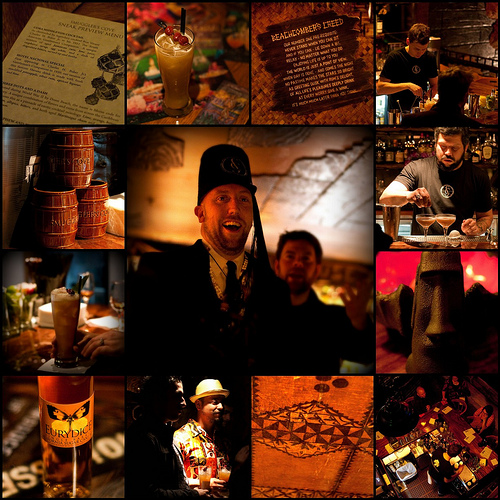
Every time we used to go to Alameda’s Forbidden Island, we sighed and wondered what it would take to convince its proprietor, Martin Cate, to open a bar like this closer to our house. It took a while, but our rum-soaked dreams have come true.
If anything, Smuggler’s Cove may turn out to be even more amazing than its East Bay cousin. Sure, there’s no outdoor patio (but really, given the shortage of sunny San Francisco days, I doubt we’d miss it), and the small space has the potential to get awfully crowded. But that wasn’t the case at last night’s media preview, where a handful of cocktail writers got the chance to sample five drinks out of the 80-plus offerings that the bar will serve come next Tuesday’s opening night.
What sets Smuggler’s Cove apart from the tiki pack is its focus on top-notch bartending talent (Martin’s gathered an enviable collection of West Coast heavy hitters), quality ingredients, and solid technique. It’s a serious rum-focused bar with retro-tropical decor, but there’s refreshingly little of the tongue-in-cheek cheesiness that you might expect. (Don’t get me wrong, I love me some ooga-booga. But I like a well-made, properly measured cocktail even more.)
And speaking of well-made cocktails, there were many to sample last night. A favorite of many guests, the Chadburn — rum, tawny port, pear liqueur, and a dash of Xocolatl Mole Bitters — takes its name from the gizmo that telegraphs changes in speed from the ship’s bridge to the engine room. The Hotel Nacional Special, which made its debut in 1939’s Gentleman’s Companion, combines pineapple, silver rum, apricot liqueur, and lime. Three more drinks — the frothy Cora Middleton, a spicy Three Dots and a Dash highball, and the island standby of J Wray & Ting — rounded out the night’s abbreviated menu.
The space itself is a marvel. The main level features a one-man bar that’s as snug and seemingly as well-designed as a yacht, surrounded by a handful of barstools and two walls of rum, rum, and more rum (and a few select spirits). Overlooking the main bar, an inviting balcony area — decorated with the requisite thatch walls and colorful puffer-fish and net-float lights — clusters armchairs around tables made to resemble old rum crates. Down a flight of ship-like stairs, a larger bar — comfortable enough for two shakers and a barback — boasts an even-larger array of rums. A low-ceilinged sitting area manages to feel cozy rather than claustrophobic, in part due to a two-story water feature that rises back to the entry.
A series of sold-out friends-and-family preview nights are scheduled for this weekend, with opening night slated for next Tuesday, December 8. It’s sure to be difficult to get a seat for weeks to come, but I know that once the crowds die down a bit, we’ll be dropping anchor in this cove quite often.
Smuggler’s Cove
650 Gough Street
San Francisco, CA 94102
415.869.1900
bar culture, drinks
8 Comments »




Posted by Anita on 11.30.09 5:16 PM
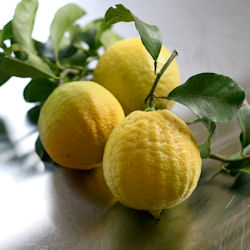 We’re in the initial planning stages of Menu for Hope, the annual food bloggers’ charity raffle that benefits the World Food Programme. If you’re a blogger, check out Pim’s page on how to get in on the fun.
We’re in the initial planning stages of Menu for Hope, the annual food bloggers’ charity raffle that benefits the World Food Programme. If you’re a blogger, check out Pim’s page on how to get in on the fun.
But whether or not you have your own blog, I could use your help: What kind of prize would you like to see offered here on Married …with dinner?
In the past, our prizes have covered a lot of bases, from “Best of the Ferry Building” local food baskets, a set of Drink of the Week cocktail notecards, and even a custom mixology service.
The food baskets have been the most popular, year to year, but they’re a pain to shop for, and a hassle to ship. And relative to the prizes from other blogs, they’ve never done all that well. I’m game to do the goody basket again, if that’s what you all really love, but I can’t help but wonder what other treats might entice you to open your wallet for a good cause. Books? Gift cards? Something creative? Something homemade?
Tell me.
giving back, Menu for Hope, other blogs
3 Comments »




Posted by Anita on 11.30.09 9:46 AM

With all the hullabaloo about 100-mile Thanksgiving, I’m going to go out on a limb and say that this is possibly the easiest Dark Days Challenge week of the year. Maybe it’s because we’ve done this for three years now, and our holiday menu rarely changes much. Maybe it’s because nobody thinks it’s odd to plan this particular meal far in advance, including ordering the main course well before the first leaves turn colors. Maybe it’s because Thanksgiving is one of the few times each year when Americans eat with the seasons, whether they’re aware of it or not. But to me, planning a locavore Thanksgiving celebration isn’t just fun, it’s also pretty simple.
My mom, sister, and brother-in-law joined us this year, and our family feast included a big pasture-raised bird from Bill Niman’s BN Ranch, with all the traditional sides: Shredded brussels sprouts sauteed with bacon, mashed potatoes and gravy, Grandma Anne’s stuffing, and a new-to-us recipe for sweet potatoes that kicks the usual sickly-sweet toppings to the curb with thyme and a dash of red pepper. And it wouldn’t be Thanksgiving without a big slice of pumpkin pie to round out the food coma. (I don’t like pumpkin, but I’ll boldly claim once again this pie will win over even the most vehement squash haters.) Our only non-local dishes were two bowls of cranberry sauce — one plain, one fancy — but since our friend Jeanne bought the berries direct from the Cape Cod farmer who grew them and toted them home in her carry-on bag, I’m not going to lose a lot of sleep over this little lapse.
Some in our family would say that the best part of Thanksgiving is actually the leftovers, including turkey/pork-sausage hash with poached eggs, a riff on Chuck’s holiday turkey gumbo (made with local Dungeness crabs in place of shrimp), and of course good-old turkey sandwiches on delicious homemade bread.
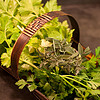



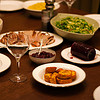
Farmers and food artisans who created the ingredients for this week’s meal:
BN Ranch, Bolinas: Heritage turkey
Mariquita Farm, Watsonville: russet potatoes, sweet potatoes
Balakian Farms, Reedley: pumpkin
Dirty Girl Produce, Santa Cruz: shallot
Catalán Family Farm, Hollister: onions
Fatted Calf, Napa: bacon
Spring Hill Cheese Company, Petaluma: butter
Guisto’s Vita-Grain, South San Francisco: flour (pie crust, stuffing bread)
Clover Organic, Petaluma: cream
Vella Cheese, Sonoma: dry Jack cheese
Iacopi, Half Moon Bay: brussels sprouts, garlic
G&S Farms, Brentwood: corn (stripped and frozen in August)
Bariani, Sacramento: Olive oil
Soul Food Farm, Vacaville: pastured eggs
Hamada Farms, Kingsburg: clementines
Fleur, Napa and Mackenzie, Sebastopol: wine
…and our own homegrown sage, parsley, celery, and thyme
Exemptions: Salt, pepper, sugar, yeast, nutmeg, cinnamon, cranberries (hand-carried from Massachusetts by Jeanne)
Dark Days challenge, Eat Local Challenge, holidays & occasions, locavore
4 Comments »




Posted by Anita on 11.24.09 9:22 AM
 We’ve always called it “Grandma Anne’s stuffing”, but one year I discovered the recipe for our favorite Thanksgiving side-dish is much older than we knew.
We’ve always called it “Grandma Anne’s stuffing”, but one year I discovered the recipe for our favorite Thanksgiving side-dish is much older than we knew.
When my grandfather passed away, I inherited his mammoth recipe box. Buried amid a slew of tortured 1970s-era gourmet recipes were a small, weathered stack of old recipe cards, written in a puzzling mixture of English and Italian (sometimes combined in one dazzling portmanteau, like “saurcraoti”). Most of the recipes were neatly lettered in a spidery convent hand on old ledger cards, but a few were obviously cut from the bottom of longer letters from my great-grandmother, Annunciata, to my grandmother, Anne; the back sides of the recipes offer snippets of a longer, advice-laden conversations at the very beginning of her marriage to my grandfather.
One such card, titled Impieno per Gallina (hen stuffing) is dated “1939 NY”, and bears an incredibly strong resemblance to our family’s traditional Thanksgiving stuffing. The quantities are smaller — even a big chicken wouldn’t need the giant bowl of filling that a turkey requires — but the ingredients are unmistakable: onion, celery, Parmesan, sage, and a pinch of nutmeg.
Now, I realize that it’s impossibly foolish to offer you my family’s stuffing recipe, heirloom or not, because everyone I’ve ever met is fiercely loyal to their own traditional ideas of Thanksgiving fare. And while you may be able to get away with adjustments to the turkey, or to any number of other side dishes, most people would rather fight than switch when it comes to the dressing. But just in case you’re game for starting a new tradition, feel free to borrow ours.
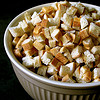


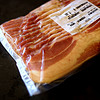
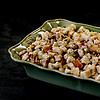
Great-Grandma Ciata’s Turkey Stuffing
1/4 to 1/2 pound bacon, diced fine
1 small onion, chopped
2 cloves garlic, minced
2 cups finely chopped celery
1/4 cup chopped parsley
bread from 1-1/2 loaves, cubed and dried (4 to 5 quarts)
2 cups chicken stock or turkey broth
1/4 cup shredded Parmesan or other dry cheese
2T fresh sage, minced
dash of nutmeg
In a cold frying pan, place the bacon, onion, garlic, celery, and parsley. Saute over low heat, being careful not to brown. Remove from heat.
Meanwhile in a large bowl, moisten the bread cubes with the stock/broth. Add the cheese, sage, nutmeg, and salt and pepper to taste. Combine with the bacon mixture, then bake in the bird, in a foil-covered casserole, or in a slow cooker.
family, holidays & occasions, recipes
13 Comments »




Posted by Anita on 11.22.09 11:31 AM
 Possibly the only thing I love more than food is travel. I just don’t feel right unless there’s at least one trip on the horizon, preferably two. We’ve been lucky enough lately to spend three of the last four weekends on the road — on a spontaneous trip to Los Angeles, then back down to Long Beach for Matt’s photography class, and then up to Sea Ranch to celebrate Sean’s 40th birthday.
Possibly the only thing I love more than food is travel. I just don’t feel right unless there’s at least one trip on the horizon, preferably two. We’ve been lucky enough lately to spend three of the last four weekends on the road — on a spontaneous trip to Los Angeles, then back down to Long Beach for Matt’s photography class, and then up to Sea Ranch to celebrate Sean’s 40th birthday.
But all this gallivanting around — especially over the weekends, when our biggest and best farmers markets are held — makes it rough to eat local. We’re lucky enough to have a shop or two in San Francisco that really pays attention to the issues of local eating, but when summer comes to an end, even their 100-mile offerings can make it hard to shop on a whim.
Our chicken-and-egg CSA keeps us stocked with a relatively painless source of fallback protein, and we’re pretty good at freezing, canning, and otherwise putting up food for just these sorts of circumstances. In a regular post-travel week, we’d probably have pasta bolognese one night, chili or sloppy joes for another dinner, and maybe chicken soup for a third. But this week marks the start of the 3rd Annual Dark Days Eat Local Challenge, so I wanted to have a photo- and post-worthy recipe to share.
We’re still pulling carrots and a small handful of beans out of our garden, so our first side-dish was a simple combination of quick-braised vegetables. And since we’ve got local sources for rice, not being able to get to the farmers market for local potatoes or other starches was no hardship. I knew we had some chicken in the freezer from our last CSA delivery, so I just had to find a new way to prepare it. (After four years of blogging and three years in this particular challenge, I’ve pretty much used up my stash of tried-and-true recipes!)
Because we’ve been up to our ears in tomatoes from the garden, I wanted to avoid most of the Italian-style recipes that would take us back in a tomato-y direction. And since it’s finally feeling like autumn around here, I craved a recipe with a heartier presence, one that would give us a good dose of internal warmth for the cool evening. This traditional Alsatian dish fit the bill quite nicely: Simple enough to whip together on a weeknight from easily-sourced local ingredients, but pretty and delicious enough to share with you. A simple snack of baguette, cheese, and radishes from our garden kept us happy while the chicken braised, and dinner was on the table in just about an hour.


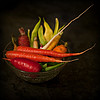

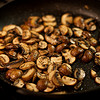
Poulet au Riesling
– adapted from Jean-Georges Vongerichten in Food & Wine
5T unsalted butter, at room temperature
a 3-1/2-pound chicken, quartered
1 large shallot, minced
2T brandy
1 cup dry Riesling or other spicy/fruity dry wine
6 ounces white or brown mushrooms, sliced 1/4 inch thick
1T flour
1/3 cup cream
Rinse and dry the chicken parts, and season with salt and pepper. Melt 2T of the butter in a large skillet; add the chicken and cook over medium heat until lightly browned, turning to brown all sides.
Add the shallot to the pan and saute for 1 minute. Add the brandy — flambé it for added flavor, if you like — then add the wine. Cover and simmer over medium-low heat until the chicken breasts are just cooked through. Transfer the breasts to a plate and cover. Continue to simmer the legs about 10 minutes longer, then remove them to the same plate with the breasts.
While the chicken simmers, melt 2T of the butter in a second skillet. Add the mushrooms and cook over low heat until the liquid evaporates. Season with salt and pepper, then increase the heat to medium and saute until browned.
Make beurre manié with the remaining butter and the flour. Stir the cream into the skillet with the chicken, and bring to a simmer. Gradually whisk the beurre manié into the cooking liquid and simmer while whisking, at least 3 minutes. Add the mushrooms and adjust seasoning to taste. Return the chicken to the skillet and briefly reheat. Serve with rice or noodles.
Farmers and food artisans who created the ingredients for this week’s meal:
Soul Food Farm, Vacaville: chicken
Dirty Girl Produce, Santa Cruz: shallot
Spring Hill Cheese Company, Petaluma: butter
Korbel, Geyserville: brandy
Handley Cellars, Philo: Gewürztraminer
Far West Fungi, Moss Landing: cremini mushrooms
Guisto’s Vita-Grain, South San Francisco: flour
Clover Organic, Petaluma: cream
Massa Organics, Hamilton City: rice
Semifreddi’s, Alameda: sweet baguette
Andante Dairy, Petaluma: Picolo triple-cream cheese
…and our own homegrown radishes, carrots, and beans
Dark Days challenge, locavore, meat, recipes
4 Comments »




Posted by Anita on 11.19.09 8:53 AM
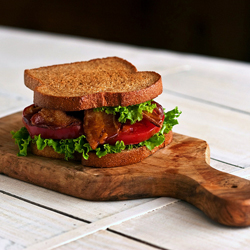 I’m pretty proud of most of the photography on our blog. I’ve won an award or two, and I’ve even taught people how to shoot better cocktail photos. But even though I’d gotten pretty handy behind the lens, for the life of me I could not shoot a beautiful sandwich. (If you don’t believe me, check out some of my older posts.)
I’m pretty proud of most of the photography on our blog. I’ve won an award or two, and I’ve even taught people how to shoot better cocktail photos. But even though I’d gotten pretty handy behind the lens, for the life of me I could not shoot a beautiful sandwich. (If you don’t believe me, check out some of my older posts.)
This competence gap of mine had gotten so bad, I’d basically scratched sandwiches off the blog to-do list. I even participated in Michael Ruhlman’s Grow-Your-Own BLT Challenge this summer, but the end result was so photographically uninspiring — so utterly unworthy of all the effort we put into growing, butchering, curing, smoking, kneading, and whisking every last ingredient we used — that I never wrote about it here. (Though I did recap, briefly, here.)
All that changed last weekend, when I took the class that will forever change the way I think about photographing food in a studio setting.
For years, I’d drooled over other blogger‘s accounts of the food-styling workshops led by Food Fanatics Denise Vivaldo and Cindie Flannigan, but had never taken the plunge and signed up myself. But when I heard they’d teamed up with food photographer (and MattBites blogger extraordinaire) Matt Armendariz to host a special two-day workshop just for food bloggers, I knew the time had come.
During Saturday’s session, Denise and Cindie walked our small group through a number of food-styling tasks, first demonstrating techniques, then setting up stations in Matt’s studio kitchen for us to practice ourselves. Although Cindie demonstrated a handful of non-edible styling tricks (like using petroleum jelly to add a juicy glow, or propping up a stack of pancakes with makeup sponges) she always demonstrated edible alternatives (like freezing syrup to keep it viscous, or using a kitchen torch to get a hamburger deliciously browned). All through the class, Denise kept us laughing with snippets of industry gossip and a rolling patter of hilarious quips to illustrate key lessons. (My favorite: “The longer you cook a piece of meat, the more it looks like George Hamilton!” So true.)
On Sunday, each student chose a project to put real-world skills to the test. As we prepped our dishes for their moment in the spotlight, Cindie and Denise stepped in to offer suggestions and share tricks. The kitchen hummed with a gaggle of bloggers hand-arranging strands of pasta in a bowl, selecting only the reddest pomegranate arils to garnish a salad (and then arranging them with tweezers!), melting pizza cheese with a heat gun, and bulking up the bottom of a bowl of curry to keep the prettier ingredients from sinking to the bottom.
For my own project, I knew I was in a safe place to tackle my sandwich fears. Denise showed me three different ways to cook bacon so that the edges stayed curly and appetizing, taught me to cook toast to a perfect golden-brown glow, and stood by as I sorted through a pile of lettuce to find the freshest, prettiest leaves. After stacking and restacking the ingredients in various combinations, I was able to create a BLT that actually looked as good as I knew it would taste.
I chose a relatively simple setting for my “hero” sandwich, and waited for my turn at one of the two shooting stations Matt had positioned in the abundant natural light of the studio’s roll-up doors. One of the most enjoyable parts of the day was watching my classmates set up their projects, place their props, adjust their tripod positions, and fiddle with the details. Blogging is such a solitary activity; it was a real treat to watch other people’s creative processes up close. Matt worked with each of us to find the best angle for our shots, adjust lighting, suggest changes to props, and generally hold hands and help us feel confident about our own abilities.
The class wasn’t cheap — $695 for two days of combined demos and hands-on workshop — but even as an experienced photographer, I felt it was worth the expense. There are precious few opportunities to learn food styling from reputable stylists at the top of their game, fewer still to work one-on-one with one of the country’s top food photographers. Having all three of these experts together in a single, collaborative workshop was invaluable, and getting to play in a professional food-photography studio was the icing on the cake.
The biggest and most pleasant surprise of the weekend was just how much everyone in the class collaborated, helping each other choose our project subjects, select appropriate props from Matt’s amazing inventory, set up our cameras to capture the best shots, and make adjustments to food on the set. Though we all were working at different levels — some were more experienced at styling but needed help with their cameras, and vice-versa — we all helped each other get great results.
At the moment, Food Fanatics doesn’t have any additional styling-plus-photography classes like this one scheduled, but that’s due to change soon: A repeat of the blogger-specific class is slated for late spring/early summer 2010. (Watch the Food Fanatics blog for details.) If you’re just interested in the styling aspect, Denise and Cindie will be teaching two classes in January: a 3-day food-styling workshop in Long Beach, and a 2-day hands-on food styling class in San Francisco at the The Art Institute.

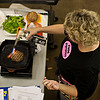



Food Fanatics
Professional site: Food Fanatics
Food styling classes: Culinary Entrepreneurship
Blog: Food Fanatics Unwashed
Twitter: @FoodFanatics
Matt Armendariz
Professional site: Matt Armendariz Photography
Food & photo blog: MattBites
Twitter: @MattArmendariz
classes, other blogs
12 Comments »




Posted by Anita on 10.09.09 8:47 PM

A few weekends ago, we had the pleasure of heading out to Vacaville to help Soul Food Farm rebuild some of the chicken houses that were destroyed in their fire last month. We spent the day in an open-air workshop under the big oaks, working with a dozen or so other volunteers, wielding powertools and hefting coop components to and fro. At lunchtime, we gathered around the farmhouse table and refueled with Soul Food Farm chicken (naturally) and a plethora of side-dishes contributed by friends and neighbors. It felt great to do an honest day’s work out in the fresh air — it felt very poignant to be working so hard in the shadow of the blackened hills you see above.
The farm did have insurance, but a high deductible with a lot of exclusions (no coverage for lost income from the chicks that died, nor for the lost pasture, for example) means that Soul Food Farm still desperately needs our help.
I know it’s hard in this financial atmosphere to send money off to strangers, however touching their story. So here are some ways to help this weekend that give you something delicious in exchange for your money:
Eat Dinner at Il Cane Rosso: Michelin-star chef Daniel Patterson is holding a fundraiser to benefit the farm at his restaurant Il Cane Rosso on Sunday, October 11. The cost of the three-course menu (served family-style), is $50 per person, including wine but exclusive of tax and gratuity. For reservations, call (415) 391-7599.
Come Party at Pizzaiolo: Tickets for the party this Sunday are sold out, but you can still get in the door — with a complimentary ticket — if you win one of the silent auction prizes (see below). And you want to bid on these great items.
Bid at the Online Auction: I know everyone says their charity auction has great prizes, but seriously folks. Check this out:
- Five baby chicks from Soul Food Farm — you want eggs, you’ll get ’em!
- Tickets to the sold-out City Arts Lecture with Michael Pollan & Wendell Berry,
plus signed copies of all of Pollan’s books
- A chance to pitch your manuscript to Chronicle Books editorial director
- A cheese master-class with Janet Fletcher, author of The Cheese Course
- Dinner for two in the kitchen at world-renowned Chez Panisse
- Portrait session with Bart Nagel including a retouched headshot
- A slot in one of master preservist June Taylor’s preserve-making classes
- Your choice of four different personal chef dinners and experiences
- A suckling pig for your holiday table from Clark Summit Farm
- Beautiful artisan-made jewelery, photographic prints, and other works of art
There are tons of other prizes — these are just my very favorites — and many of the coolest ones have no bids yet! So get on over there and win something cool. But don’t dally: Bidding closes in less than 24 hours (4 pm Pacific time, Saturday, October 10)
Join the Chicken & Egg CSA: Yep, just like a veggie CSA box, only this one’s got protein. Better still, deliveries are just once a month, and you get to pick how many chickens and dozens of eggs you want for each delivery. Drop-off points are available in Emeryville, Bernal Heights/Potrero Hill, Berkeley, and Hayes Valley on alternating weeks. And the prices are a good value, compared with the retail costs of the same items. Oh, and if you donated $25 or more to the Soul Food Farm Fire Fund, they will gladly credit your donation against your CSA fee. How cool is that?!

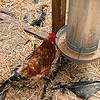

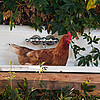

Soul Food Farm / Alexis and Eric Koefoed
6046 Pleasants Valley Road
Vacaville, CA 95688
(707) 469-0499
farms & farmers, giving back, locavore, other stuff
4 Comments »
























































